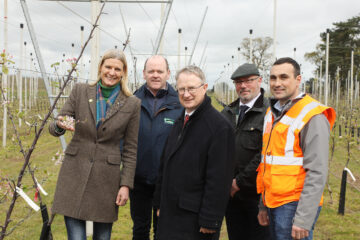Converging evidence points to the agency’s skewing its glyphosate report to reach a desired conclusion
In March 2015, the International Agency for Research on Cancer, or IARC, issued a report labeling the weed killer glyphosate a “probable carcinogen.” This ruling caused consternation in the scientific and agricultural communities. Glyphosate, which is manufactured by Monsanto and is the active ingredient in the company’s popular Roundup, is one of the most widely-used herbicides worldwide. It is cheap, effective, and has low toxicity. IARC’s ruling goes against the assessment of every other agency that has evaluated the compound, including the U.S. Environmental Protection Agency, the European Food Safety Authority, and the World Health Organization, of which IARC is a part.
IARC, which is based in Lyon, France, makes its assessments by convening a panel of experts to consider all the available evidence from human, animal, and mechanistic studies regarding a potential cancer threat. The agency then classifies a given substance as carcinogenic (Group 1), probably carcinogenic (Group 2A), possibly carcinogenic (Group 2B), or not classifiable as to carcinogenicity. For its glyphosate evaluation IARC formed a Working Group of 16 experts who reviewed the evidence for nearly a year before issuing its report in March 2015. The Working Group was subdivided into subgroups to assess the human evidence, the animal studies, and the mechanistic/laboratory studies. At the end of the review process, the panel designated glyphosate as a “probable carcinogen” based on the animal evidence, which was judged to be “sufficient.” We will come back to this point later.
What is not widely known is that the agency’s classification of a substance does not take into account the degree of exposure to that substance in the general population. Rather, in IARC’s terminology, it evaluates “hazard” – the possibility that a substance could cause cancer under some possible condition – as opposed to “risk,” which refers to the likelihood that actual exposure in the real world might cause cancer. Needless to say, when headlines trumpet the latest IARC assessment, the public and the media assume that classification of an agent as “probably carcinogenic” must have some direct relevance to human health, even when actual human exposures are at levels too low to cause adverse health effects.Today In: Science & Technology
Over the past few years, when scientists have questioned the agency’s process and some of its recent classifications, rather than addressing specific criticisms, IARC officials have argued that their methods are sound and not in need of improvement, and have implied that their critics have conflicts-of-interest.
In the past year, however, as IARC’s glyphosate report has been subjected to scrutiny by scientists and investigative journalists, a number of increasingly disturbing questions have come to light. Three major, independent pieces of the “back-story” on IARC’s glyphosate assessment are presented below.
Reanalysis of the animal and epidemiologic evidence
In August 2016, Robert Tarone published a commentaryentitled “On the International Agency for Research on Cancer classification of glyphosate as a probable human carcinogen” in the European Journal of Cancer Prevention. Tarone, who is a statistician who spent most of his career at the National Cancer Institute, re-examined the animal studies cited by IARC. In such studies, typically a strain of rodents is divided into one or more “treatment” groups and a control group – and the former is exposed to a test substance at increasing dose levels – in this case, glyphosate – while the control group is unexposed to the test substance. As animals die they are examined, and at the end of the study the remaining animals are sacrificed and their organs are examined for benign and malignant changes.
What is crucial is to determine whether the treatment group shows robust evidence of a greater “tumor yield” compared to controls. In relatively small animal experiments there will likely be ups-and-down, but one is looking for a consistent excess of tumors in the treated group. Most persuasive would be evidence of a dose-response relationship – that is, the more of the substance that the test animals are given, the greater the tumor yield. Furthermore, one might expect to see consistency in male and female animals, if the substance is carcinogenic.
What Tarone found is that the IARC panel highlighted certain positive results from the rodent studies they relied upon in the deliberations, and, glaringly, ignored contradictory negative results from the same studies. He also found that an inappropriate statistical test was used, making the data look more impressive than they actually were. Tarone concluded, “When all relevant data from the rodent carcinogenicity studies of glyphosate relied on by the Working Group are evaluated together, it is clear that the conclusion that there is sufficient evidence that glyphosate is an animal carcinogen is not supported empirically. Even a conclusion that there is limited evidence of animal carcinogenicity would be difficult to support…”
In reviewing the human (i.e., epidemiologic) studies, Tarone found that IARC’s case for glyphosate’s association with non-Hodgkin’s lymphoma also resulted from favoring certain study results, rather than considering the totality of the evidence.
In the past week, two new insights into the agency’s glyphosate assessment have emerged, coalescing into a full-blown scandal.
Revelations from a deposition in a law suit against Monsanto
A blogger, who uses the pen-name Risk-Monger, examined the transcripts of a deposition related to cases against Monsanto involving the scientist Christopher Portier. Portier, an American statistician who worked for the federal government for over thirty years, was the special advisor to the IARC panel that issued the report declaring glyphosate to be “probably carcinogenic.” The transcripts show that during the same week in March 2015 in which IARC published its glyphosate opinion, Portier signed a lucrative contract to act as a litigation consultant for two law firms that were preparing to sue Monsanto on behalf of glyphosate cancer victims. His contract contained a confidentiality clause barring Portier from disclosing his employment to other parties. Portier’s financial conflict-of-interest has been confirmed by the UK newspaper The Times.
It turns out that it was Portier himself, who as chair of an IARC committee in 2014 had proposed that the agency undertake a review of glyphosate in the first place. He then went on to play a key role in the deliberations resulting in the IARC conclusion that glyphosate is probably carcinogenic. In view of the new revelations, it appears that, rather than being the objective scientist he has portrayed himself to be, he may have had a preconceived plan to use the IARC ruling, which he played a major role in shaping, to cash in on the ensuing litigation campaign. In the years following the IARC glyphosate decision, Portier has frequently claimed that he had no conflicts-of-interest and that he has never taken a cent for his glyphosate work. At the same time, he and IARC generally have portrayed any scientist who questioned the evidence of glyphosate’s carcinogenicity as being motivated by pro-industry bias. This has proved an effective tactic for suppressing substantive arguments based on the scientific evidence.
IARC’s editorial process in the glyphosate report
On the heels of Risk-Monger’s exposé, three days ago, Kate Kelland, a journalist for Reuters, who has been investigating IARC’s recent assessments, published findings indicating that the glyphosate document underwent significant editing to remove null results and to strengthen positive conclusions. Kelland obtained a draft of the key chapter of the report devoted to animal studies, which became available as part of the lawsuits against Monsanto, and she compared the draft with the final, published report. She found 10 significant instances in which “a negative conclusion about glyphosate leading to tumors was either deleted or replaced with a neutral or positive one.” Kelland’s findings indicate that the original draft found little animal evidence that glyphosate was a carcinogen. Her textual analysis provides confirmation of Tarone’s independent re-analysis of the original studies. Furthermore, Portier admits in his deposition that the interim report produced by the animal subgroup during the Working Group meeting also concluded that there was “limited evidence of animal carcinogenicity.” He proclaims ignorance of when or how the conclusion was upgraded to “sufficient evidence of animal carcinogenicity” during the deliberations of the entire Working Group. It is crucial to repeat that the classification of glyphosate as probably carcinogenic to humans relied entirely upon the conclusion that there was sufficient evidence of animal carcinogenicity (because the epidemiologic evidence was not strong).
All of this points to a trusted agency redacting the evidence to suit its predetermined and preferred story-line.
What is at stake
In addition to providing the basis for litigation by US law firms, IARC’s 2015 opinion on glyphosate provided powerful ammunition to environmental activists, anti-GMO groups, NGO’s, and organic foods industry lobbyists on both sides of the Atlantic in their campaign to ban glyphosate. For the past two years, the European Union has been trying to reauthorize the weed killer but has been opposed by politicians in Member States who have been swayed by the anti-glyphosate crusade. A decision to ban or to phase out use of glyphosate will hurt both farmers and consumers by decreasing crop yields, increasing the costs of produce, and requiring substitution of herbicides about which less is known and which may pose a greater health risk. A final decision is expected next month.
The revelations about IARC’s glyphosate determination carry crucial lessons regarding relations among scientific evidence, policy, and public opinion. Decisions about the safety of chemical residues in the environment are challenging and require critical evaluation of the available evidence by experts in the relevant disciplines. These can only be achieved through a hashing out of the relevant evidence in a forum in which qualified scientists with no professional or political stake in the question at hand have an important role in order to keep the proceedings honest.
In the highly-charged and polarized climate surrounding questions involving public health and the environment, it is only too easy for advocates to gain support for their cause by appealing to public concern. Often this concern relates to trace levels of a chemical in our food, water, or environment. But the two sides in the debate are not equal. Evidence, no matter how weak or questionable, of a positive association is readily accepted as pointing to a serious threat. In contrast, even when there is superior evidence that calls into question the existence of threat, this simply does not have the same power to persuade concerned citizens.
A closely related point is that the prevailing view of conflicts-of-interest is one-sided and naïve and represents a major obstacle to achieving rationality in the public discussion of hotly contested questions like glyphosate. To be sure, industry has its clear interests, and, of course, these should be taken into account. In fact, the awareness of industry interests is, by now, built into our thinking. Things are quite different when it comes to seeing the interests at work on the other side. Given that deliberations on these matters involve human beings, we need to take it as axiomatic that all parties may be influenced by financial considerations – or equally importantly — by ideological and professional agendas. We delude ourselves if we think that environmental activists and allied scientists (including academic and government researchers) engaged in these questions are free of their own interests.
The recent revelations regarding IARC’s glyphosate assessment throw these issues into stark relief. Scientists and agencies need to be transparent. It’s not acceptable for an agency to argue that “we are impartial authorities, trust us.” Rather, we should follow the rule, “Trust but verify” – or rather, “Distrust but verify.” These revelations make it clear that, where high-stakes issues involve powerful beliefs, substantial financial rewards, and opportunities for advancement, neither individuals nor authoritative agencies can be assumed to be free of conflicts-of-interest.
Source: Check out his website. Wrote by Geoffrey Kabat – Former Contributor – Science & Technology – Oct 23, 2017



